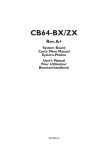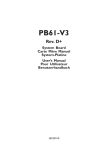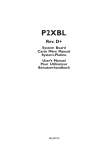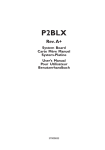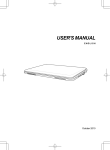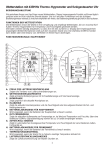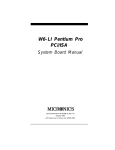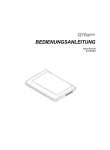Download Rev. C+ - Elhvb.com
Transcript
P2XBL Rev. C+ System Board Carte Mère Manuel System-Platine Users Manual Pour Utilisateur Benutzerhandbuch 35290847 Copyright This publication contains information that is protected by copyright. No part of it may be reproduced in any form or by any means or used to make any transformation/ adaptation without the prior written permission from the copyright holders. This publication is provided for informational purposes only. The manufacturer makes no representations or warranties with respect to the contents or use of this manual and specifically disclaims any express or implied warranties of merchantability or fitness for any particular purpose. The user will assume the entire risk of the use or the results of the use of this document. Fur ther, the manufacturer reserves the right to revise this publication and make changes to its contents at any time, without obligation to notify any person or entity of such revisions or changes. © 1998. All Rights Reserved. Trademarks Microsoft® MS-DOS® , Windows TM and Windows® 95 are registered trademarks of Microsoft Corporation. Intel® , Pentium® II and CeleronTM are registered trademarks of Intel Corporation. Award is a registered trademark of Award Software, Inc. Other trademarks and registered trademarks of products appearing in this manual are the properties of their respective holders. Caution: Danger of explosion if battery incorrectly replaced. Replace only with the same or equivalent type recommended by the manufacturer. Dispose of used batteries according to the battery manufacturers instructions. FCC and DOC Statement on Class B This equipment has been tested and found to comply with the limits for a Class B digital device, pursuant to Part 15 of the FCC rules. These limits are designed to provide reasonable protection against harmful interference when the equipment is operated in a residential installation. This equipment generates, uses and can radiate radio frequency energy and, if not installed and used in accordance with the instruction manual, may cause harmful interference to radio communications. However, there is no guarantee that interference will not occur in a particular installation. If this equipment does cause harmful interference to radio or television reception, which can be determined by turning the equipment off and on, the user is encouraged to try to correct the interference by one or more of the following measures: Reorient or relocate the receiving antenna. Increase the separation between the equipment and the receiver. Connect the equipment into an outlet on a circuit different from that to which the receiver is connected. Consult the dealer or an experienced radio TV technician for help. Notice: 1. The changes or modifications not expressly appro ved by the party responsible for compliance could void the user's authority to operate the equipment. 2. Shielded interface cables must be used in order to comply with the emission limits. Table of Contents / Sommaire / Inhaltsverzeichnis Chapter 1 - Introduction 1.1 1.2 Features and Specifications................................................................... Package Checklist ...................................................................................... 4 7 Chapter 2 - Hardware Installation 2.1 2.2 2.3 2.4 2.5 2.6 System Board Layout .............................................................................. DIP Switch Settings of the Processors ......................................... Jumper Settings for Clearing CMOS Data................................. Jumper Settings for CPU Front Side Bus.................................... Jumper Settings for Wake-On-Keyboard/Mouse..................... Connectors .................................................................................................... Chapter 3 - Award BIOS Setup Utility 3.1 3.2 3.3 3.4 Entering the Award BIOS Setup Utility ........................................ Setting the Date and Time................................................................... Selecting the Hard Drive and Floppy Drive Type................... Selecting the Drive to be Searched First for an Operating System...................................................................................... 3.5 Setting the External System Bus Clock of the Processor.. 3.6 Selecting an IRQ for the External Modem ................................. 3.7 Selecting the Method of Powering-off the System ................. 3.8 Selecting the Power Lost Resume State ...................................... 3.9 Selecting the Wake-On-Keyboard/Mouse Function................ 3.10 Using the System Health Monitor Function ............................... 3.11 Loading Fail-Safe Settings/Optimal Settings ............................... 3.12 Setting the Supervisor/User Password ......................................... Chapter 4 - Supported Softwares 4.1 8 9 10 11 12 13 19 20 21 22 23 25 26 28 29 33 36 36 Drivers and Utility .................................................................................... 38 Appendix A - System Error Messages A.1 POST Beep ................................................................................................... 39 A.2 Error Messages ............................................................................................ 39 Note: The users manual in the provided CD contains detailed information about the system board. If, in some cases, some information doesnt match those shown in this manual, this manual should always be regarded as the most updated version. To view the users manual, insert the CD into a CD-ROM drive. The autorun screen (Main Board Utility CD) will appear. Click Users Manual. Chapter 1 - Introduction / Introduction / Einleitung 1.1 Features and Specifications Caractéristiques et Spécifications Leistungsmerkmale und Technische Daten 1.1.1 Features / Caractéristiques / Leistungsmerkmale Chipset Intel 440BX AGPset Processor 233/66MHz, 266/66MHz, 300/66MHz, 333/66MHz, 350/100MHz, 400/100MHz or 450/100MHz Pentium II processor with 512KB L2 cache 266/66MHz, 300/66MHz, 300A/66MHz, 333/66MHz Intel CeleronTM processor System Memory The system board supports 8MB to 768MB memory. It is equipped with three 168-pin DIMM sockets using x64/x72 unbuffered or registered PC SDRAM, 3.3V. The PC SDRAMs supported are PC-66 SDRAM for 66MHz FSB and PC-100 SDRAM for 100MHz FSB. The system board also supports ECC (uses x72 PC SDRAM). DIMMs 1MBx64/x72 2MBx64/x72 4MBx64/x72 Memory Size 8MB 16MB 32MB * Registered DIMM only. DIMMs 8MBx64/x72 16MBx64/x72 32MBx64/x72 Memory Size 64MB 128MB 256MB* Expansion Slots The system board is equipped with 1 dedicated AGP slot, 3 dedicated PCI slots, 2 dedicated 16-bit ISA slots and 1 shared PCI/ ISA slot. All PCI and ISA slots are bus masters. Desktop Management Interface (DMI) The system board comes with a DMI 2.0 built into the BIOS. The DMI utility in the BIOS automatically records various information about your system configuration and stores these information in the DMI pool, which is a part of the system board's Plug and Play BIOS. DMI, along with the appropriately networked software, is designed to make inventory, maintenance and troubleshooting of computer systems easier. 4 Introduction ATX Double Deck Ports 2 USB ports 2 DB-9 serial ports 1 DB-25 parallel port 1 mini-DIN-6 PS/2 keyboard port 1 mini-DIN-6 PS/2 mouse port Connectors 1 connector for IrDA interface 2 IDE connectors 1 floppy connector 1 20-pin ATX power supply connector 1 3-pin WOL (Wake-On-LAN) connector 1 SB-LINK connector 3 fan connectors for CPU, chassis and AGP fans PCI Bus Master IDE Controller Two PCI IDE interfaces support up to four IDE devices Ultra DMA/33 supported (Synchronous Ultra DMA mode - data transfer rate up to a maximum of 33MB/sec.) PIO Mode 3 and Mode 4 Enhanced IDE (data transfer rate up to 16.6MB/sec.) Bus mastering reduces CPU utilization during disk transfer ATAPI CD-ROM, LS-120 and ZIP supported IrDA Interface The system board is equipped with an IrDA connector for wireless connectivity between your computer and peripheral devices. It supports peripheral devices that meet the IrDA or ASKIR standard. USB Ports The system board is equipped with two USB ports. USB allows data exchange between your computer and a wide range of simultaneously accessible external Plug and Play peripherals. BIOS Award BIOS, Windows 95 Plug and Play compatible Flash EPROM for easy BIOS upgrades 1.1.2 Intelligence / Intelligence / Intelligente Ausstattungsteile Monitors Processor Temperature and Overheat Alarm The system board is able to detect the temperature of the processor. An alarm will sound in case of processor overheat. 5 1 1 Introduction Monitors Processor/Chassis Fan Speed and Failure Alarm The system board is able to detect the fan speed (RPM-Revolution Per Minute) and alerts you to attend to any irregularity that may damage your system. Monitors Power Voltages and Failure Alarm The system board is able to detect the output voltage of the power supply. An alarm will sound warning you of voltage irregularity. Automatic Fan Off The CPU fan will automatically turn off once the system enters the Suspend mode. This prevents system overheat and prolongs fan life. Dual Function Power Button Depending on the setting in the BIOS setup, this switch will allow your system to enter the Soft-Off or Suspend mode. External Modem Ring-on The Modem Ring-on feature allows the system that is in the Suspend mode or Soft Power Off mode to wake-up/power-on to respond to incoming calls. This feature supports external modem only. RTC Timer to Power-on the System The RTC installed on the system board allows your system to automatically power-on on the set date and time. Wake-On-LAN Ready The Wake-On-LAN function allows the network to remotely wake up a Soft Power Down (Soft-Off) PC. Your LAN card must support the remote wakeup function. Important: The 5VSB power source of your power supply must support ≥720mA (minimum). Wake-On-Keyboard/Wake-On-Mouse This function allows you to use the keyboard or mouse to power-on the system. Refer to sections 2.5 (chapter 2) and 3.9 (chapter 3) for more information. Important: The power button will not function once a keyboard password has been set in the KB Power On Password field of the Integrated Peripherals setup. You must type the password to power-on the system. 6 Introduction Virus Protection Most viruses today destroy data stored in hard drives. The system board is designed to protect the boot sector and partition table of your hard disk drive. 1.2 Package Checklist Liste de Vérification de lEmballage Verpackungsliste The system board package contains the following items: The system board A users manual One 40-pin IDE hard disk cable One 34-pin floppy disk drive cable One CD If any of these items are missing or damaged, please contact your dealer or sales representative for assistance. 7 1 Chapter 2 - Hardware Installation Installation du Matériel Installation der Hardware 2.1 System Board Layout Position de la Carte Système Aufbau der Hauptplatine 8 Hardware Installation 2.2 DIP Switch Settings of the Processors Positionnement des Cavaliers des Processeurs DIP Schaltereinstellungen für den Prozessor The table below shows the supported processor s and their corresponding DIP switch settings. In the example above: Switch Switch Switch Switch Processor 1: Off 2: Off 3: On 4: On Frequency Ratio 66MHz 100MHz 233MHz 350MHz 3.5x 266MHz 400MHz 4x 300MHz 450MHz 4.5x 333MHz Future processor 5x Future processor Future processor 5.5x Future processor Future processor 6x Future processor Future processor 6.5x SW1 9 2 2 Hardware Installation Processor Frequency Ratio 66MHz 100MHz Future processor Future processor 7x Future processor Future processor 7.5x Future processor Future processor 8x SW1 Note: Intel Pentium II processor or Intel Celeron TM processor supports VID (Voltage Identification). The switching voltage regulator on the system board will automatically set the voltage regulator according to the voltage of the processor. 2.3 Jumper Settings for Clearing CMOS Data Positionnement des Cavaliers pour Effacer les Données CMOS Jumpereinstellungen zum Löschen der CMOS Daten Jumper JP5 - CMOS Clear To load the default values stored in the ROM BIOS, please follow the steps below. 1. Power-off the system and unplug the power cord. 2. Set JP5 pins 2 and 3 to On. Wait for a few seconds and set JP5 back to its default setting, pins 1 and 2 On. 3. Plug the power cord and power-on the system. 1 2 3 1-2 On: Normal (default) 1 2 3 2-3 On: Clear CMOS Data 10 Hardware Installation 2.4 Jumper Settings for CPUs Front Side Bus Positionnement des cavaliers pour le bus frontal du processeur Jumpereinstellungen fuer CPU Vorderseitenbus The default setting of jumper JP3 is Auto - the system will automatically run according to the FSB of the processor. If you wish to overclock a 66MHz FSB processor to 100MHz, set pins 1 and 2 to Off. 1 2 1 2 On : Auto(default) Off : 100MHz Warning: Overclocking a 66MHz FSB processor to 100MHz willl provide better system performance. However, not all 66MHz FSB processors are capable of running at 100MHz bus speed. Therefore, if you are unable to boot your system when set at 100MHz, make sure to set JP3 back to its default setting. 11 2 2 Hardware Installation 2.5 Jumper Settings for Wake-On-Keyboard/Mouse Positionnement des Cavaliers pour Réveil-Sur-Clavier/ Souris Jumpereinstellungen für die Wake-On Tastatur/Maus Jumper JP7 - Wake-on-Keyboard/Mouse To use the keyboard or mouse to poweron the system, please follow the steps below. 1. Set JP7 to 2-3 On, enable. 2. Keyboard/Mouse Power On in the Integrated Peripherals setup of the Award BIOS must be set accordingly. Refer to section 3.9 (chapter 3) for more information. 1 2 3 1-2 On: Disable (default) 1 2 3 2-3 On: Enable Warning: 1. The power button will not function once a keyboard password has been set in the KB Power On Password field of the Integrated Peripherals setup. You must type the password to power-on the system. 2. The 5VSB power source of your power supply must support ≥720mA (minimum). 12 Hardware Installation 2.6 Connectors / Connecteurs / Anschlüsse 2.6.1 Floppy Disk Drive Controller and IDE Interface Contrôleur de Lecteur de Disquette et Interface IDE Diskettenlaufwerkcontroller und IDE Interface : Primar y IDE : Secondary IDE : FDC Important: If you encountered problems while using an ATAPI CD-ROM drive that is set in Master mode, please set the CD-ROM drive to Slave mode. Some ATAPI CD-ROMs may not be recognized and cannot be used if incorrectly set in Master mode. 2.6.2 IrDA Connector Connecteur IrDA IrDA Anschlüsse Pin Function 1 IRTX 2 GND 3 IRRX 4 N. C. 5 VCC 13 2 2 Hardware Installation 2.6.3 CPU Fan Connector Connecteur du Ventilateur de CPU CPU Kühlung Anschluß Pin Function 1 On/off CTRL 2 +12V 3 Sense Pin Function 1 On/off CTRL 2 +12V 3 Sense 2.6.4 Chassis Fan Connector Connecteur de Châssis de Ventilateur Anschluß Kühlungsgehäuse 14 Hardware Installation 2.6.5 AGP Fan Connector Connecteur de Ventilateur AGP Anschluß AGP Kühlung Pin Function 1 GND 2 +12V 3 N.C. 2.6.6 Wake-On-LAN (WOL) Connector Connecteur Réveil-Sur-LAN (WOL) Wake-On-LAN (WOL) Anschluß Pin Function 1 5VSB (720mA) 2 GND 3 Signal Important: The 5VSB power source of your power supply must support ≥720mA (minimum). 15 2 2 Hardware Installation 2.6.7 SB-LINK Connector Connecteur de SB-LINK Anschluß SB-LINK 2.6.8 LEDs and Switches Commutateurs et LED LEDs und Schalter 16 Pin Function 1 PC-PCI-GNTx 2 DGND 3 Key 4 PC-PCI-REQx 5 DGND 6 SERIRQ Hardware Installation SB-LED (ATX 5VSB Standby LED) HD-LED (Primary/Secondary IDE LED) G-LED (Green LED) ATX-SW (ATX power switch) G-SW (Green switch) RESET (Reset switch) SPEAKER (Speaker connector) KEYLOCK (Keylock and Power LED connector) Pin 1 2 3 4 5 6 7 8 9 10 11 12 13 14 15 16 17 18 19 20 21 22 23 24 25 26 27 28 Pin Assignment ATX Power Ground N. C. HDD LED Power HDD N. C. Green LED Power Green N. C. PWRBT Ground N. C. SMI Ground N. C. H/W Reset Ground N. C. Speaker Data N. C. Ground Speaker Power N. C. LED Power N. C. Ground Keylock Ground Use pins 24 to 26 for the Power LED. Important: ATX-SW (ATX Power Switch) - Depending on the setting in the BIOS setup, this switch is a dual function power button that will allow your system to enter the Soft-Off or Suspend mode. Refer to section 3.7 (chapter 3) for more information. 17 2 2 Hardware Installation 2.6.9 Power Connector Connecteur dAlimentation Netzanschluß Pin Function Pin Function 1 3.3V/14A 11 3.3V/14A 2 3.3V/14A 12 -12V 3 Ground 13 Ground 4 +5V 14 PS-ON 5 Ground 15 Ground 6 +5V 16 Ground 7 Ground 17 Ground 8 PW-OK 18 -5V 9 5VSB 19 +5V 10 +12V 20 +5V Important: Your power supply must meet the ATX specification - supporting 3.3V/14A (minimum), otherwise your system will not boot properly. 18 Chapter 3 - Award BIOS Setup Utility Utilitaire de Configuration du Award BIOS AWARD BIOS Konfigurationsprogramm 3.1 Entering the Award BIOS Setup Utility Entrer Dans lUtilitaire de Configuration du Award BIOS Aufruf des AWARD BIOS Konfigurationsprogramms Power-on the system and press <Del> to enter the utility. The main program screen will appear. Allumez le Système et appuyez sur <Del> pour entrer dans lutilitaire. Lécran du programme principal apparaîtra. Zum Aufrufen des Konfigurationsprogramms drücken Sie während des Startvorgangs die Taste <Del>. Ein Bildschirm ähnlich dem folgenden erscheint. ROM PCI/ISA BIOS CMOS SETUP UTILITY AWARD SOFTWARE, INC. STANDARD CMOS SETUP BIOS FEATURES SETUP CHIPSET FEATURES SETUP POWER MANAGEMENT SETUP PNP/PCI CONFIGURATION LOAD FAIL-SAFE SETTINGS LOAD OPTIMAL SETTINGS Esc F10 : Quit : Save & Exit Setup INTEGRATED PERIPHERALS SUPERVISOR PASSWORD USER PASSWORD IDE HDD AUTO DETECTION SAVE & EXIT SETUP EXIT WITHOUT SAVING : Select Item ↑↓→← (Shift) F2 : Change Color 19 3 Award BIOS Setup Utility 3.2 Setting the Date and Time Paramétrage de la Date et de lHeure Einstellen des Datums und der Zeit ROM PCI/ISA BIOS STANDARD CMOS SETUP AWARD SOFTWARE, INC. Date (mm:dd:yy) : Mon, Jan 5 1998 Time (hh:mm:ss) : 13: 27: 50 HARD DISKS Primary Master : Primary Slave : Secondary Master : Secondary Slave : TYPE SIZE CYLS HEAD Auto 0 0 0 Auto 0 0 0 Auto 0 0 0 Auto 0 0 0 PRECOMP LANDZ SECTOR MODE 0 0 0 Auto 0 0 0 Auto 0 0 0 Auto 0 0 0 Auto Drive A : 1.44M, 3.5 in. Drive B : None Base Memory : 640K Extended Memory : 64512K Other Memory : 384K Total Memory : 65536K Video : EGA/VGA Halt on : All Errors Esc F10 : Quit : Save & Exit Setup ↑↓→← (Shift)F2 : Select Item : Change PU/PD/+/- : Modify 1. Select Standard CMOS Setup in the main program screen and press <Enter>. Sélectionnez Standard CMOS Setup dans lécran du programme principal et appuyez sur <Entrée>. Standard CMOS Setup in dem Hauptbildschirm auswählen, und die Eingabetaste (Enter) drücken. 2. Set the correct date and time in the Date and Time fields respectively. Sélectionnez la date et lheure correcte dans les champs Date et Time respectivement. Jeweils korrekte Wer te in die Eingabefelder Date (Datum) und Time (Zeit) eingeben. 20 Award BIOS Setup Utility 3.3 Selecting the Hard Drive and Floppy Drive Type Sélectionnez le Type de Disque Dur et de Lecteur de Disquette Auswahl der Festplatte und des Diskettenlaufwerks ROM PCI/ISA BIOS STANDARD CMOS SETUP AWARD SOFTWARE, INC. Date (mm:dd:yy) : Mon Jan 5 1998 Time (hh:mm:ss) : 13: 27: 50 HARD DISKS Primary Master Primary Slave Secondary Master Secondary Slave TYPE SIZE CYLS HEAD : Auto 0 0 0 : Auto 0 0 0 : Auto 0 0 0 : Auto 0 0 0 PRECOMP LANDZ SECTOR MODE 0 0 0 Auto 0 0 0 Auto 0 0 0 Auto 0 0 Auto 0 Drive A : 1.44M, 3.5 in. Drive B : None Base Memory : 640K Extended Memory : 64512K Other Memory : 384K Total Memory : 65536K Video : EGA/VGA Halt on : All Errors Esc F10 : Quit : Save & Exit Setup ↑↓→← (Shift)F2 : Select Item : Change PU/PD/+/- : Modify 1. Select Standard CMOS Setup in the main program screen and press <Enter>. Sélectionnez Standard CMOS Setup dans lécran du programme principal et appuyez sur <Entrée>. Standard CMOS Setup in dem Hauptbildschirm auswählen, und die Eingabetaste (Enter) drücken. 2. Select Auto for the hard disk drive(s) installed in your system. The BIOS will auto-detect the HDD & CD-ROM drive at the POST stage and show the IDE for the HDD & CD-ROM drive. If a hard disk has not been installed, select None and press <Enter>. Sélectionnez Auto pour le(s) disque(s) dur(s) installés dans votre système. Le BIOS détectera automatiquement le Disque Dur et le Lecteur CD-ROM durant la phase POST et affichera lIDE du Disque Dur et du Lecteur CD-ROM. Si aucun disque dur na été installé, sélectionnez None et appuyez sur <entrée>. Im Eintrag Hard Disk Drive(s) (Festplatte) Auto auswählen. Das Programm entdeckt die Festplatte sowie das CD-ROM Laufwerk während der Initialisierung automatisch. Ist keine Festplatte installier t, aktivieren Sie den Eintr ag None. Eingabetaste (Enter) drücken. 21 3 3 Award BIOS Setup Utility 3. Set the type of floppy drive installed in the Drive A and Drive B fields. The options are None, 360K, 1.2M, 720K, 1.44M and 2.88M. Paramétrez le type de lecteur de disquette installé dans les champs Drive A et Drive B. Les options sont None, 360K, 1.2M, 720K, 1.44M et 2.88M. Im Eintrag Floppy Drive (Diskettenlaufwerk) wählen Sie Drive A (Laufwerk A) und Drive B (Laufwerk B). Die Optionen sind None (Kein), 360K, 1.2M, 720K, 1.44M und 2.88M. 3.4 Selecting the Drive to be Searched First for an Operating System Sélectionner le Lecteur qui doit être Détecté en premier par un Système dExploitation Auswahl des Bootlaufwerks ROM PCI/ISA BIOS BIOS FEATURES SETUP AWARD SOFTWARE, INC. : Virus Warning : CPU L1 Cache : CPU L2 Cache CPU L2 Cache ECC Checking : : Quick Power On Self Test : Boot Sequence : Swap Floppy Drive : Boot Up Floppy Seek : Boot Up NumLock Status : Typematic Rate Setting Typematic Rate (Chars/Sec) : : Typematic Delay (Msec) : Security Option : PCI/VGA Palette Snoop OS Select For DRAM > 64MB : HDD S.M.A.R.T. Capability : Disabled Enabled Enabled Enabled Enabled A, C, SCSI Disabled Disabled On Disabled 6 250 Setup Disabled Non-OS2 Disabled ESC F1 F5 F6 F7 : : : : : ↑↓→← Quit : Select Item Help PU/PD/+/- : Modify Old Values (Shift) F2 : Color Load Fail-Safe Settings Load Optimal Settings 1. Select BIOS Features Setup in the main program screen and press <Enter>. Sélectionnez BIOS Features Setup dans lécran de programme principal et appuyez sur <Entrée>. BIOS Features Setup in dem Hauptbildschirm auswählen, und die Eingabetaste (Enter) drücken. 2. Select the drive to be searched first in the Boot Sequence field. The default is A, C, SCSI. The other options are: C, A, SCSI; C, CDROM, A; CDROM, C, A; D, A, SCSI; E, A, SCSI; F, A, SCSI; SCSI, A, C; SCSI, C, A; C only and LS/ZIP, C. 22 Award BIOS Setup Utility Sélectionnez le lecteur qui devra être détecté en premier dans le champs Boot Sequence. La valeur par défaut est A, C, SCSI. Les autres options sont: C, A, SCSI; C, CDROM, A; CDROM, C, A; D, A, SCSI; E, A, SCSI; F, A, SCSI; SCSI, A, C; SCSI, C, A; C seulement et LS/ZIP, C. Im Boot Sequence Feld wählen Sie die Sequenz, in welcher der Computer nach einem Betriebssystem sucht. Die Optionen sind C, A, SCSI; C, CDROM, A; CDROM, C, A; D, A, SCSI; E, A, SCSI; F, A, SCSI; SCSI, A, C; SCSI, C, A; nur C und LS/ZIP, C . 3.5 Setting the External System Bus Clock of the Processor Paramétrage de lHorloge Externe de Bus Système du Processeur Auswahl des externen Systemtaktgebers Ihres Prozessors ROM PCI/ISA BIOS CHIPSET FEATURES SETUP AWARD SOFTWARE, INC. SDRAM RAS-to-CAS Delay SDRAM RAS Precharge Time SDRAM CAS Latency Time SDRAM Precharge Control DRAM Data Integrity Mode System BIOS Cacheable Video BIOS Cacheable Video RAM Cacheable 8 Bit I/O Recovery Time 16 Bit I/O Recovery Time Memory Hole At 15M-16M PCI 2.1 Compliance AGP Aperture Size (MB) CPU Clock Frequency Spread Spectrum : : : : : : : : : : : : : : : 3 3 3 Disabled Non-ECC Disabled Disabled Disabled 1 1 Disabled Disabled 64 Default Disabled **** System Health Monitor **** Current CPU Temperature : 36o C/96o F : 5000 RPM Current CPU Fan Speed 0 RPM Current Chassis Fan Speed : : Ignore CPU Temperature Limit : Ignore +3.3V Voltage : Ignore +12V Voltage : Ignore +5V Voltage : Ignore +1.5V Voltage ESC F1 F5 F6 F7 : : : : : ↑ ↓ → ← : Select Item Quit Help PU/PD/+/- : Modify Old Values (Shift) F2 : Color Load Fail-Safe Settings Load Optimal Settings 1. Select Chipset Features Setup in the main program screen and press <Enter>. Sélectionnez Chipset Features Setup dans lécran de programme principal et appuyez sur <Entrée>. Chipset Features Setup in dem Hauptbildschirm auswählen, und die Eingabetaste (Enter) drücken. 23 3 3 Award BIOS Setup Utility 2. If you are using a 66MHz FSB processor, the options are Default, 66MHz, 75MHz and 83MHz. If you are using a 100MHz FSB processor, the options are Default, 83MHz, 100MHz, 103MHz, 112MHz and 124MHz. Regardless of the type of processor used, the default setting is Default. Under this setting, the system will run at 66MHz or 100MHz depending on the processors clock frequency. If you selected an option other than Default and is unable to boot up the system, there are 2 methods of going back to its default setting. Method 1: Clear the CMOS data by following the procedure in section 2.3 (chapter 2) of this manual. The fields in the BIOS Setup will automatically be set to its default settings. Method 2: Press the <Inser t> key and Power b utton simultaneously until the power-on screen appears. This will allow the system to boot according to the FSB of the processor. Now press the <Del> key to enter the Award BIOS setup utility. Select Chipset Features Setup and set the CPU Clock Frequency field to Default or a suitable clock frequency. Si vous utilisez un processeur FSB 66 MHz, les options par défaut sont, 66MHz, 75MHz et 83 MHz. Si vous utilisez un processeur FSB 100MHz, les options par défaut sont 83MHz, 100MHz, 103MHz, 112MHz et 124MHz, indépendamment du type de processeur utilisé, le paramètre par défaut est Default. Sous ce paramétrage, le système travaillera en 66MHz ou 100MHz en fonction de la fréquence dhorloge du processeur. Si vous sélectionnez une option autre que Default et que vous ne puissiez pas amorcer le système, il existe 2 méthodes pour rétablir les paramètres par défaut. Méthode 1: Effacez les données du CMOS en suivant la procédure décrite dans la Section 2.3 (Chapitre 2) de ce manuel. Tous les champs dans le programme dinstallation du BIOS seront positionnés automatiquement à leur valeur par défaut. Méthode 2: Appuyez sur la touche <Insert> et sur le bouton de mise sous tension en même temps jusquà ce que lalimentation décran apparaisse. Ceci permettra au système de redémarrer en fonction du FSB du processeur. Maintenant appuyez sur la touche <Del> afin dentrer dans lutilitaire dinstallation du Award BIOS. Sélectionnez Chipset Features Setup et positionnez le champ CPU Clock Frequency sur Default ou sur la fréquence dhorloge qui convient. 24 Award BIOS Setup Utility Falls Sie mit einem FSB-Prozessor mit 66MHz arbeiten, sind die Optionen Standard, 66MHz, 75MHz und 83MHz. Arbeiten Sie mit einem FSB-Prozessor mit 100MHz, sind die Optionen Standard, 83MHz, 100MHz, 103MHz, 112MHz und 124 MHz. Die Standardeinstellung ist auf Default eingestellt, ungeachtet des Prozessor typs, mit dem Sie arbeiten. Je nach Taktfrequenz funktionier t das System mit dieser Einstellung bei 66MHz oder 100MHz. Wählen Sie eine andere Option als Default aus und das System kann damit nicht gestar tet werden, gibt es zwei Methoden, die Standardeinstellung wiederherzustellen. Methode 1: Die CMOS-Daten müssen durch Befolgen des in Abschnitt 2.3 (Kapitel 2) in diesem Handbuch beschriebenen Vorgangs gelöscht werden. Sämtliche Bereiche im BIOS-Setup werden dann automatisch auf ihre Standardeinstellung eingestellt. Methode 2: Die Taste <Inser t> und die Netztaste gleichzeitig drücken, bis der Einschaltschirm erscheint. Dies ermöglicht ein Star ten des Systems gemäß dem FSB des Prozessor s. Zum Aktivieren des Dienstprogramms des Award-BIOS-Setup muß die <Del>-Taste gedrückt werden. Dann Chipset Features Setup auswählen und die CPU Clock Frequency auf Default pder eine geeignete Taktfrequenz einstellen. 3.6 Selecting an IRQ for the External Modem Sélectionner une IRQ pour le Modem Externe IRQ Bestimmung für ein externes Modem ROM PCI/ISA BIOS POWER MANAGEMENT SETUP AWARD SOFTWARE, INC. ACPI Function Power Management PM Control by APM Video Off Method Video Off After MODEM Use IRQ Standby Mode Suspend Mode HDD Power Down VGA Active Monitor Soft-Off by PWR-BTTN Resume by Ring Resume by LAN Resume by Alarm : Disabled : User Define : Yes : DPMS : Suspend :3 : Disabled : Disabled : Disabled : Disabled : Instant-Off : Disabled : Disabled : Disabled ESC F1 F5 F6 F7 : : : : : Quit ↑ ↓ → ← : Select Item Help PU/PD/+/- : Modify Old Values (Shift) F2 : Color Load Fail-Safe Settings Load Optimal Settings 25 3 3 Award BIOS Setup Utility 1. Select Power Management Setup in the main program screen and press <Enter>. Sélectionnez Power Management Setup dans lécran de programme principal et appuyez sur <Entrée>. Power Management Setup in dem Hauptbildschirm auswählen, und die Eingabetaste (Enter) drücken. 2. Select an IRQ for the external modem in the MODEM Use IRQ field. The options are IRQ 3, 4, 5, 7, 9, 10 or 11. You need to select an IRQ only if you are using the modem ring-on function. Sélectionnez une IRQ pour le modem externe dans le champ MODEM Use IRQ Les options sont IRQ 3, 4, 5, 7, 9, 10 ou 11. Vous devez sélectionner une seule IRQ seulement si vous utilisez la fonction de sonnerie du modem. In dem Feld MODEM Use IRQ eine entsprechende IRQBestimmung für das externen Modem vornehmen. Die Optionen sind IRQ 3, 4, 5, 7, 9, 10 und 11. Eine Einstellung ist nur dann nötig, wenn bestimmte Funktionen (ring-on) des Modems benutzt werden sollen. 3.7 Selecting the Method of Powering-off the System Sélection de la Méthode pour Eteindre le Système Auswahl der Abschaltmethode ROM PCI/ISA BIOS POWER MANAGEMENT SETUP AWARD SOFTWARE, INC. ACPI Function : Disabled Power Management : User Define PM Control by APM : Yes Video Off Method : DPMS Video Off After : Suspend MODEM Use IRQ :3 Standby Mode : Disabled Suspend Mode : Disabled HDD Power Down : Disabled VGA Active Monitor : Disabled Soft-Off by PWR-BTTN : Instant-Off Power Lost Resume State : Keep Off Resume by Ring : Disabled Resume by LAN : Disabled Resume by Alarm : Disabled ESC F1 F5 F6 F7 : : : : : Quit ↑ ↓ → ← : Select Item Help PU/PD/+/- : Modify Old Values (Shift) F2 : Color Load Fail-Safe Settings Load Optimal Settings 1. Select Power Management Setup in the main program screen and press <Enter>. 26 Award BIOS Setup Utility Sélectionnez Power Management Setup dans lécran de programme principal et appuyez sur <Entrée>. Power Management Setup in dem Hauptbildschirm auswählen, und die Eingabetaste (Enter) drücken. 2. Select the method of powering-off the system in the Soft-Off by PWR-BTTN field. The options are Hold 4 Sec. and Instant-Off. Sélectionnez la Méthode pour éteindre le système dans le champ Soft-Off by PWR-BTTN. Les options sont Hold 4 Sec. et Instant-Off. In dem Feld Soft-Off by PWR-BTTN können Sie die Methode bestimmen, mit welcher Ihr Rechner ausgeschaltet wird. Die Optionen sind Hold 4 Sec. (4 Sekunden warten) und Instant-Off (Direktabschaltung). Hold 4 Sec. If the power button is pushed and released in less than 4 seconds, the system enters the Suspend mode. Push and release it again in less than 4 seconds to restore. Pushing the power button for more than 4 seconds will power-off the system. Si le bouton de mise sous tension est poussé puis relâché en moins de 4 secondes, le système entrera en mode suspend. Poussez le et relâchez le à nouveau en moins de 4 secondes pour restaurer la fonction. Le fait dappuyer sur le bouton de mise sous tension pendant plus de 4 secondes éteindra le système. Wird die Netztaste gedrückt und innerhalb von 4 Sekunden wieder losgelassen, schaltet sich das System in den SuspendModus. Ein erneutes Drücken mit einem Loslassen innerhalb von 4 Sekunden stellt den Normalzustand wieder her. Wird die Netztaste für die Dauer von über 4 Sekunden gedrückt gehalten, schaltet sich das System ab. Instant-Off Pressing and then releasing the power button at once will immediately power-off the system. Le fait dappuyer sur le bouton de mise sous tension en une fois éteindra le système immédiatement. Normales Drücken der Netztaste schaltet das System augenblicklich ab. 27 3 3 Award BIOS Setup Utility 3.8 Selecting the Power Lost Resume State Choisir létat de Redémarrage Après Coupure de Courant Auswaehlen des PWR Lost Resume Status ROM PCI/ISA BIOS POWER MANAGEMENT SETUP AWARD SOFTWARE, INC. ACPI Function : Disabled Power Management : User Define PM Control by APM : Yes Video Off Method : DPMS Video Off After : Suspend MODEM Use IRQ :3 Standby Mode : Disabled Suspend Mode : Disabled HDD Power Down : Disabled VGA Active Monitor : Disabled Soft-Off by PWR-BTTN : Instant-Off Power Lost Resume State : Keep Off Resume by Ring : Disabled Resume by LAN : Disabled Resume by Alarm : Disabled ESC F1 F5 F6 F7 : : : : : Quit ↑ ↓ → ← : Select Item Help PU/PD/+/- : Modify Old Values (Shift) F2 : Color Load Fail-Safe Settings Load Optimal Settings 1. Select Power Management Setup in the main program screen and press <Enter>. Sélectionnez Power Management Setup dans lécran de programme principal et appuyez sur <Entrée>. Power Management Setup in dem Hauptbildschirm auswählen, und die Eingabetaste (Enter) drücken. 2. Select the PWR Lost Resume State field. The options are: Sélectionnez PWR Lost Resume State. Les options sont In dem Feld PWR Lost Resume State. Die Optionen sind: Keep Off When power returns after an AC power failure, you must press the Power button to power-on the system. Quand le courant revient après une coupure, vous devez appuyer sur le bouton dalimentation pour redémarrer le système. Wenn die Leistung nach einem AC-Leistungsfehler zurueckkehr t, muessen Sie den Ein-/Ausschalter druecken, um das System zu starten. 28 Award BIOS Setup Utility Turn On When power returns after an AC power failure, the system will automatically power-on. Quand le courant revient après une coupure, le système redémarre automatiquement. Wenn die Leistung nach einem AC-Leistungsfehler zurueckkehr t, wird das System automatisch gestartet. Last State When power returns after an AC power failure, the operating session where you left off before power failure occurs will resume. Quand le courant revient après une coupure, la session va recommencer là où vous étiez avant la coupure. Wenn die Leistung nach einem AC-Leistungsfehler zurueckkehr t, wird der Betrieb dor t wieder aufgenommen, wo Sie waren, bevor der Leistungsfehler aufgetreten ist. 3.9 Setting the Wake-On-Keyboard/Mouse Function Activer la Fonction Réveil-Sur-Clavier/Souris Aktivieren der Wake-On Tastatur/Maus Funktion ROM PCI/ISA BIOS INTEGRATED PERIPHERALS AWARD SOFTWARE, INC. IDE HDD Block Mode IDE Primary Master PIO IDE Primary Slave PIO IDE Secondary Master PIO IDE Secondary Slave PIO IDE Primary Master UDMA IDE Primary Slave UDMA IDE Secondary Master UDMA IDE Secondary Slave UDMA On-chip Primary PCI IDE On-chip Secondary PCI IDE USB Keyboard Support Init Display First : : : : : : : : : : : : : Enabled Auto Auto Auto Auto Auto Auto Auto Auto Enabled Enabled Disabled AGP KBC Input Clock Onboard FDC Controller Onboard Serial Port 1 Onboard Serial Port 2 UART2 Mode Select : : : : : 8MHz Enabled 3F8/IRQ4 2F8/IRQ3 Normal Onboard Parallel Port : Parallel Port Mode : ECP Mode Use DMA : EPP Mode Select : Keyboard/Mouse Power On : 378/IRQ7 ECP+EPP 3 EPP1.7 Disabled ESC F1 F5 F6 F7 : : : : : Quit ↑ ↓ → ← : Select Item Help PU/PD/+/- : Modify Old Values (Shift) F2 : Color Load Fail-Safe Settings Load Optimal Settings 29 3 3 Award BIOS Setup Utility 1. Select Integrated Peripherals in the main program screen and press <Enter>. Sélectionnez Integrated Peripherals dans lécran de programme principal et appuyez sur <Entrée>. Integrated Peripherals in dem Hauptbildschirm auswählen, und die Eingabetaste (Enter) drücken. 2. Select Keyboard/Mouse Power On. The options are: Sélectionnez Keyboard/Mouse Power On. Les options sont: Im Keyboard/Mouse Power On Feld sind folgende Optionen möglich: Disabled Default setting / Valeur par défaut / Voreinstellung. Warning / Attention / Warnung: If JP7 was previously enabled with a password set in the KB Power On Password field, and now you wish to disable the Wake-OnKeyboard (password) function, make sure to set this field to disabled prior to setting JP7 to disabled (1-2 On). You will not be able to boot up the system if you fail to do so. Si JP7 a été activé précédemment avec un mot de passe paramétré dans le KB Power On Password, et que vous désiriez maintenant désactiver la fonction de Réveil par Clavier (mot de passe), assurez-vous de positionner le champ sur désactivé avant de positionner JP7 sur désactivé (1-2 Sélectionné). Si vous ne procédez pas ainsi, vous ne pourrez pas amorcer le système. Falls JP7 zuvor mit einem Kennwort im Feld KB Power On Password aktiviert worden ist und Sie nun die Funktion Wake-On-Keyboard (Kennwort) deaktivieren wollen, muß dieses Feld auf Deaktiviert eingestellt werden, bevor JP7 auf Deaktiviert (1-2 Ein) eingestellt wird, da sonst das System nicht gestartet werden kann. Password When this option is selected, the KB Power On Password field will appear. Move the cursor to this field and press <Enter>. Enter your password. You 30 Award BIOS Setup Utility can enter up to 5 characters. Type in exactly the same password to confirm, then press <Enter>. Quand cette option est sélectionnée, la rubrique KB Power On Password apparaîtra. Déplacez votre curseur dans cette rubrique et appuyez sur Entrée. Entrez votre mot de passe. Vous pouvez entrer jusquà 5 caractères. Tapez exactement le même mot de passe pour confirmer et appuyez sur Entrée. Wenn diese Option gewaehlt wird, wird das KB Power On Password -Feld erscheinen. Bewegen Sie den Cursor auf dieses Feld und dr uecken Sie <Enter>. Geben Sie Ihr Passwort ein. Sie koennen bis zu 5 Zeichen eingeben. Tippen Sie nocheinmal genau dasselbe Passwor t ein, um dieses zu bestaetigen und druecken Sie dann <Enter>. Important / Important / Wichtig: The power button will not function once a keyboard password has been set in the KB Power On Password field. You must type the correct password to power-on the system. Le bouton de mise sous tension ne fonctionnera plus une fois quun mot de passe aura été entré dans le champ KB Power On Password. Vous devez taper le mot de passe correct pour allumer votre système. Nach dem Einstellen eines Tastatur-Kennwortes im Feld KB Power On Password wird die Netztaste nicht funktionieren. Zum Einschalten des Systems muß das richtige Kennwort eingegeben werden. Hot Key When this option is selected, the KB Power On Hot Key field will appear. Move the cursor to this field to select a function key you would like to use to power-on the system. The options are from CtrlF1 to Ctrl-F12. Quand cette option est choisie, la rubrique KB Power On Hot Key apparaîtra. Déplacez le curseur dans cette rubrique pour sélectionner la touche de fonction que vous souhaitez utiliser pour allumer le système. Les options vont de Ctrl-F1 à Ctrl-F12. 31 3 3 Award BIOS Setup Utility Wenn diese Option gewaehlt wird, wird das Feld fuer die KB Power On Hot Key fuer den Star t des Computers erscheinen. Bewegen Sie die Maus auf dieses Feld um eine Tastenkombination zu waehlen, mit der Sie das System star ten moechten. Die Optionen sind Ctrl-F1 bis Ctrl-F12. Mouse Left When this option is selected, double-click the left button of the mouse to power-on the system. Quand cette option est choisie, double-cliquez sur le bouton gauche de la souris pour allumer le système. Wenn diese Option gewaehlt wird, druecken Sie zweimal die linke Maustaste, um das System zu starten. Mouse Right When this option is selected, double-click the right button of the mouse to power-on the system. Quand cette option est choisie, double-cliquez sur le bouton droit de la souris pour allumer le système. Wenn diese Option gewaehlt wird, druecken Sie zweimal die rechte Maustaste, um das System zu starten. Any Key You can press any key to power-on the system. Vous pouvez appuyez sur nimporte quelle touche pour allumer le système. Sie koennen jede Taste druecken, um das System zu starten. Keyboard 98 When this option is selected, press the wake up key of the Windows 98 compatible keyboard to power-on the system. Quand cette option est sélectionnée, appuyez sur la touche Réveil du clavier compatible Windows 98 pour activer le système. Wenn diese Option gewählt wurde, drücken Sie die Aufweck-Taste der mit dem Windows ® 98 kompatiblen Tastatur, um das System einzuschalten. 32 Award BIOS Setup Utility Important / Important / Wichtig: Make sure JP7 is set to 2-3 On. Refer to Jumper Settings for Wake-On-Keyboard/Wake-On-Mouse in Chapter 2 of this manual for more information. Assurez vous que JP7 est positionné sur la sélection 2-3. Pour plus de renseignements, reportez-vous à Positionnement des Cavaliers pour Réveil-Sur-Clavier/Souris au chapitre de ce manuel. Es ist darauf zu achten, daß sich JP7 in der Einstellung 2-3 An befindet. Schauen Sie unter Jumpereinstellungen für die WakeOn-Tastatur/Maus in Kapitel 2 dieses Handbuches nach, um weitere Information zu erhalten. 3.10 Using the System Health Monitor Function Utilisez de System Health Monitor Arbeiten der System Health Monitor ROM PCI/ISA BIOS CHIPSET FEATURES SETUP AWARD SOFTWARE, INC. SDRAM RAS-to-CAS Delay SDRAM RAS Precharge Time SDRAM CAS Latency Time SDRAM Precharge Control DRAM Data Integrity Mode System BIOS Cacheable Video BIOS Cacheable Video RAM Cacheable 8 Bit I/O Recovery Time 16 Bit I/O Recovery Time Memory Hole At 15M-16M PCI 2.1 Compliance AGP Aperture Size (MB) CPU Clock Frequency Spread Spectrum : : : : : : : : : : : : : : : 3 3 3 Disabled Non-ECC Disabled Disabled Disabled 1 1 Disabled Disabled 64 Default Disabled **** System Health Monitor **** Current CPU Temperature : 36oC/96o F : 5000 RPM Current CPU Fan Speed 0 RPM Current Chassis Fan Speed : : Ignore CPU Temperature Limit : Ignore +3.3V Voltage : Ignore +12V Voltage : Ignore +5V Voltage : Ignore +1.5V Voltage ESC F1 F5 F6 F7 : : : : : Quit ↑ ↓ → ← : Select Item Help PU/PD/+/- : Modify Old Values (Shift) F2 : Color Load Fail-Safe Settings Load Optimal Settings CPU Temperature Limit If the temperature of the processor is over the temperature limit set in this field (70oC/158oF recommended), an alarm will sound warning you of system overheat. The sound of the alarm is continuous low to high beeps. Si la température du processeur est supérieure à la température limite spécifiée dans ce champs (70°C/158°F recommandés), une alarme retentira pour vous aver tir de la surchauffe de votre système. Le son émis par dalarme sont des bips continus faibles ou forts. 33 3 3 Award BIOS Setup Utility Übersteigt die Temperatur des Prozessors die in diesen Feldern eingestellte Temperatur (70°C/158°F empfohlen), er tönt ein akustisches Signal, das eine Überhitzung des Systems anzeigt. Dieses akustische Signal ertönt in einem kontinuierlichen tiefen Ton bis zu hohen Tönen. +1.5V, +3.3V, +5V and +12V Voltages Set these fields to Monitor if you want the system board to detect the output voltage of the power supply. If the output voltage is over or under +1.5V/+3.3V/+5V/+12V (±10%), an alarm will sound warning you of voltage issue. The sound of the alarm is continuous low to high beeps but shorter than the temperature alarm. Positionnez ces champs sur Monitor si vous voulez que la carte système détecte le voltage de sortie de lalimentation. Si le voltage de sortie est supérieur ou inférieur à +1.5V/ +3.3V/ +5V/ +12V (±10%), une alarme retentira vous avertissant du problème de voltage. Le son de lalarme est continu allant de bips faible ver s des bips plus for ts mais plus cour ts que ceux de lalarme de température. Falls die Ausgangsspannung des Netzteils durch die System-Platine erkannt werden soll, müssen diese Felder auf Monitor eingestellt werden. Befindet sich die Ausgangsspannung oberhalb oder unterhalb +1.5V/+3.3V/+5V/+12V (±10%), ertönt ein akustisches Signal, das Sie auf eine unangemessene Spannung aufmerksam macht. Dieses akustische Signal ertönt in einem kontinuierlichen tiefen Ton bis zu hohen Tönen, ist jedoch kürzer als das akustische TemperaturWarnsignal. System Health Monitor Utility The system board comes with a System Health Monitor utility as shown on the next page. La carte système est fournie avec une utilitaire de System Health Monitor. Die System-Platine wird mit einem System Health Monitor geliefert. 34 Award BIOS Setup Utility Once this utility is installed, the system will ignore the settings in the System Health Monitor field of the Chipset Features Setup. If you are using Windows 95 or Windows NT 4.0, you may select between using the utility and the Chipset Features Setup. For other operating systems, you may only use the Chipset Features Setup. Dès que cette utilitaire est installé, le système ignora les configurations dans le champs System Health Monitor du Chipset Features Setup. Si vous utilisez Windows® 95 ou Windows NT® 4.0, vous pourriez sélectionner entre cette utilitaire ou bien Chipset Features Setup. Pour dautres systèmes dopération, vous nutilisez que Chipset Features Setup. Nach dem Installieren dieses Hilfsprogramms werden die Einstellungen im System Health Monitor-Feld der Chipset Features Setup ignorier t. Falls Sie mit Windows 95 oder Windows NT 4.0 arbeiten, können Sie auswählen, ob Sie das Hilfsprogramm oder die Chipset Features Setup anwenden wollen. Bei anderen Betriebssystemen kann nur die Chipset Features Setup angewendet werden. 35 3 3 Award BIOS Setup Utility 3.11 Loading Fail-Safe Settings/Optimal Settings Charger les Paramètres à Sécurité Relative Optimaux Laden der Fail - Safe Einstellungen / Optimierte Einstellungen The Load Fail-Safe Settings option loads the troubleshooting default values permanently stored in the ROM chips. These settings are not optimal and turn off all high performance features. You should use these values only if you have hardware problems. The Load Optimal Settings option loads optimized settings from the BIOS ROM. Use the Setup default values as standard values for your system. Loption Charger les Paramètres à Sécurité Relative charge les valeurs de recherche de pannes par défaut stockées de manière permanente dans les puces ROM. Ces paramètres ne sont pas optimum et désactives toutes les fonctionnalités à haute performance. Vous pouvez utiliser ces valeurs seulement si vous rencontrez des problèmes de matériel. Mit dieser Funktionen lassen sich Standardeinstellungen in dem permanenten ROM Speicher ablegen, die in Problemfällen geladen werden. Mit dieser Einstellung läßt sich der Computer im Standardmodus star ten. Sie sollten diese Wer te nur dann benutzen, wenn Hardwareprobleme etc. eine Star ten des Computers nicht zulassen. Mit der Auswahl Load Optimal Settings lassen sich die optimierten Einstellungen von dem BIOS ROM abrufen. Die optimierten Einstellungen sind der Standardwert. 3.12 Setting the Supervisor/User Password If you want to protect your system and the setup utility from unauthorized entry, set a password in the Supervisor Password field. If you want a user to have access only to your system but not to setup, set a password in the User Password field. Use the arrow keys to highlight the Super visor Password or User Password field and press <Enter>. The message below will appear. Enter Password: Type in the password. You can enter up to eight characters only. You will then be prompted to confirm the password. Type in exactly the same password. Make sure to set the Security Option field in the BIOS Features Setup to System or Setup. This will depend on when you would like the system to be prompted with a password. 36 Award BIOS Setup Utility Définir le Mot de Passe Superviseur/Utilisateur Si vous désirez protéger votre système et Install contre toute entrée non autorisée, paramétrez un mot de passe dans le champ Supervisor Password. Si vous désirez protéger laccès à Install seulement, mais pas votre système, paramétrez un mot de passe dans le champ User Password. Utilisez les touches fléchées pour sélectionner le champ Supervisor Password ou User Password et appuyez sur <Entrée>. Le message ci-dessous apparaîtra. Enter Password: Entrez le mot de passe. Vous êtes limité à huit caractères. Une fois que cest fait, vous serez invité à confirmer le mot de passe, entrez exactement le même mot de passe. Assurez vous de positionner le champs Security Option dans les BIOS Features Setup sur System ou Setup. Cela dépend du moment où vous désirez que le système vous demande le mot de passe. Aktivieren eines Supervisor / Benutzer Paßwortes Wenn Sie das Super visor Password aktivieren, müssen Sie vor dem Einstieg in das Konfigurationsprogramm ein Kennwor t eingeben., während das User Password den Zugang zu dem Computer ermöglicht. Wählen Sie den Eintrag Super visor Password bzw. Supervisor Password und betätigen Sie die Eingabetaste (Enter). Im erscheinenden Dialogfeld. Enter Password: Geben Sie Ihr Kennwort mit bis zu 8 Stellen ein. Betätigen Sie die Eingabetaste und geben Sie das Kennwort als Bestätigung erneut ein. Es ist darauf zu achten, daß das Feld Security Option in dem BIOS Features Setup auf System oder Setup gesetzt ist. 37 3 Chapter 4 - Supported Softwares Logiciels Supportés Unterstützte Software 4.1 Drivers and Utility Pilotes et Utilitaires Treiber und Hilfsprogramme The system board package comes with drivers for different operating systems contained in the provided CD. It also includes the System Health Monitor utility. To install the drivers and utility, please refer to the Readme file contained in the provided CD. If you are running Windows 95 (Win95, Win95+, Win95 OSR1: Windows 95 OEM Service Release 1, Win95 OSR2: Windows 95 OEM Service Release 2.0 or Win95 OSR2.1: Windows 95 OEM Service Release 2.0 plus USB Supplement), you need to run a Patch utility. Please refer to the Readme file contained in the provided CD. All steps or procedures to install software drivers are subject to change without notice as the softwares are occassionally updated. Please refer to the readme files for the latest information. 38 Appendix A - System Error Message Messages dErreur du Système Fehlernachricht des Systems When the BIOS encounters an error that requires the user to correct something, either a beep code will sound or a message will be displayed in a box in the middle of the screen and the message, PRESS F1 TO CONTINUE, CTRL-ALT-ESC or DEL TO ENTER SETUP, will be shown in the information box at the bottom. Enter Setup to correct the error. A.1 POST Beep / Pip de POST / Akustisches POST-Signal There are two kinds of beep codes in the BIOS. One code indicates that a video error has occured and the BIOS cannot initialize the video screen to display any additional information. This beep code consists of a single long beep followed by three short beeps. The other code indicates that a DRAM error has occured. This beep code consists of a single long beep. A.2 Error Messages / Messages dErreur / Fehlernachrichten One or more of the following messages may be displayed if the BIOS detects an error during the POST. This list indicates the error messages for all Awards BIOSes: CMOS BATTERY HAS FAILED The CMOS battery is no longer functional. It should be replaced. Caution: Danger of explosion if battery incorrectly replaced. Replace only with the same or equivalent type recommended by the manufacturer. Dispose of used batteries according to the battery manufacturers instructions. CMOS CHECKSUM ERROR Checksum of CMOS is incorrect. This can indicate that CMOS has become corrupt. This error may have been caused by a weak battery. Check the batter y and replace if necessary. DISPLAY SWITCH IS SET INCORRECTLY The display switch on the motherboard can be set to either monochrome or color. This indicates the switch is set to a different 39 A System Error Message setting than indicated in Setup. Determine which setting is correct, either turn off the system and change the jumper or enter Setup and change the VIDEO selection. FLOPPY DISK(S) fail (80) Unable to reset floppy subsystem. FLOPPY DISK(S) fail (40) Floppy type mismatch. Hard Disk(s) fail (80) HDD reset failed. Hard Disk(s) fail (40) HDD controller diagnostics failed. Hard Disk(s) fail (20) HDD initialization error. Hard Disk(s) fail (10) Unable to recalibrate fixed disk. Hard Disk(s) fail (08) Sector Verify failed. Keyboard is locked out - Unlock the key The BIOS detects that the keyboard is locked. Keyboard controller is pulled low. Keyboard error or no keyboard present Cannot initialize the keyboard. Make sure the keyboard is attached correctly and no keys are being pressed during the boot. Manufacturing POST loop System will repeat POST procedure infinitely while the keyboard controller is pull low. This is also used for the M/B burn in test at the factory. BIOS ROM checksum error - System halted The checksum of ROM address F0000H-FFFFFH is bad. Memory test fail The BIOS reports memory test fail if the memory has error(s). 40








































